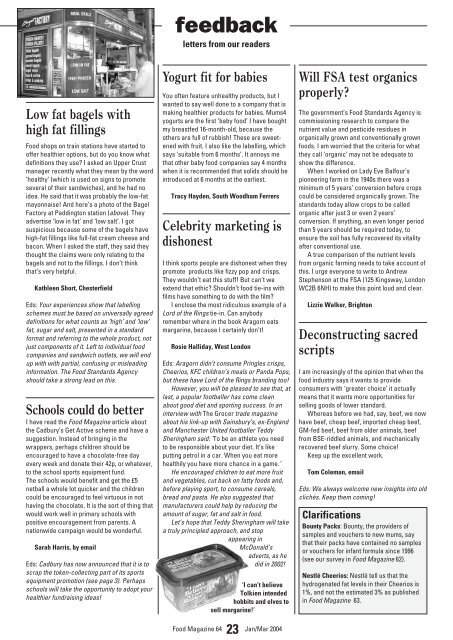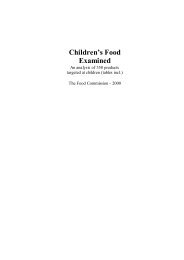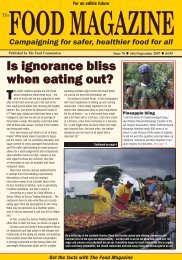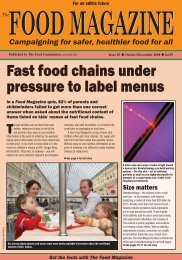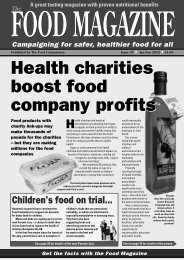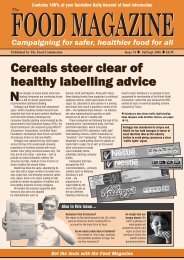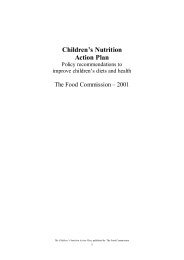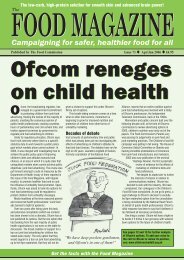Soft drinks - The Food Commission
Soft drinks - The Food Commission
Soft drinks - The Food Commission
- No tags were found...
You also want an ePaper? Increase the reach of your titles
YUMPU automatically turns print PDFs into web optimized ePapers that Google loves.
feedbackletters from our readersLow fat bagels withhigh fat fillings<strong>Food</strong> shops on train stations have started tooffer healthier options, but do you know whatdefinitions they use? I asked an Upper Crustmanager recently what they mean by the word‘healthy’ (which is used on signs to promoteseveral of their sandwiches), and he had noidea. He said that it was probably the low-fatmayonnaise! And here’s a photo of the BagelFactory at Paddington station (above). <strong>The</strong>yadvertise ‘low in fat’ and ‘low salt’. I gotsuspicious because some of the bagels havehigh-fat fillings like full-fat cream cheese andbacon. When I asked the staff, they said theythought the claims were only relating to thebagels and not to the fillings. I don’t thinkthat’s very helpful.Kathleen Short, ChesterfieldEds: Your experiences show that labellingschemes must be based on universally agreeddefinitions for what counts as ‘high’ and ‘low’fat, sugar and salt, presented in a standardformat and referring to the whole product, notjust components of it. Left to individual foodcompanies and sandwich outlets, we will endup with with partial, confusing or misleadinginformation. <strong>The</strong> <strong>Food</strong> Standards Agencyshould take a strong lead on this.Schools could do betterI have read the <strong>Food</strong> Magazine article aboutthe Cadbury’s Get Active scheme and have asuggestion. Instead of bringing in thewrappers, perhaps children should beencouraged to have a chocolate-free dayevery week and donate their 42p, or whatever,to the school sports equipment fund.<strong>The</strong> schools would benefit and get the £5netball a whole lot quicker and the childrencould be encouraged to feel virtuous in nothaving the chocolate. It is the sort of thing thatwould work well in primary schools withpositive encouragement from parents. Anationwide campaign would be wonderful.Sarah Harris, by emailEds: Cadbury has now announced that it is toscrap the token-collecting part of its sportsequipment promotion (see page 3). Perhapsschools will take the opportunity to adopt yourhealthier fundraising ideas!Yogurt fit for babiesYou often feature unhealthy products, but Iwanted to say well done to a company that ismaking healthier products for babies. Mums4yogurts are the first ‘baby food’ I have boughtmy breastfed 16-month-old, because theothers are full of rubbish! <strong>The</strong>se are sweetenedwith fruit. I also like the labelling, whichsays ‘suitable from 6 months’. It annoys methat other baby food companies say 4 monthswhen it is recommended that solids should beintroduced at 6 months at the earliest.Tracy Hayden, South Woodham FerrersCelebrity marketing isdishonestI think sports people are dishonest when theypromote products like fizzy pop and crisps.<strong>The</strong>y wouldn’t eat this stuff! But can’t weextend that ethic? Shouldn’t food tie-ins withfilms have something to do with the film?I enclose the most ridiculous example of aLord of the Rings tie-in. Can anybodyremember where in the book Aragorn eatsmargarine, because I certainly don’t!Rosie Halliday, West LondonEds: Aragorn didn’t consume Pringles crisps,Cheerios, KFC children’s meals or Panda Pops,but these have Lord of the Rings branding too!However, you will be pleased to see that, atlast, a popular footballer has come cleanabout good diet and sporting success. In aninterview with <strong>The</strong> Grocer trade magazineabout his link-up with Sainsbury’s, ex-Englandand Manchester United footballer TeddySheringham said: ‘To be an athlete you needto be responsible about your diet. It’s likeputting petrol in a car. When you eat morehealthily you have more chance in a game.’He encouraged children to eat more fruitand vegetables, cut back on fatty foods and,before playing sport, to consume cereals,bread and pasta. He also suggested thatmanufacturers could help by reducing theamount of sugar, fat and salt in food.Let’s hope that Teddy Sheringham will takea truly principled approach, and stopappearing inMcDonald’sadverts, as hedid in 2002!‘I can’t believeTolkien intendedhobbits and elves tosell margarine!’Will FSA test organicsproperly?<strong>The</strong> government’s <strong>Food</strong> Standards Agency iscommissioning research to compare thenutrient value and pesticide residues inorganically grown and conventionally grownfoods. I am worried that the criteria for whatthey call ‘organic’ may not be adequate toshow the difference.When I worked on Lady Eve Balfour’spioneering farm in the 1940s there was aminimum of 5 years’ conversion before cropscould be considered organically grown. <strong>The</strong>standards today allow crops to be calledorganic after just 3 or even 2 years’conversion. If anything, an even longer periodthan 5 years should be required today, toensure the soil has fully recovered its vitalityafter conventional use.A true comparison of the nutrient levelsfrom organic farming needs to take account ofthis. I urge everyone to write to AndrewStephenson at the FSA (125 Kingsway, LondonWC2B 6NH) to make this point loud and clear.Lizzie Walker, BrightonDeconstructing sacredscriptsI am increasingly of the opinion that when thefood industry says it wants to provideconsumers with ‘greater choice’ it actuallymeans that it wants more opportunities forselling goods of lower standard.Whereas before we had, say, beef, we nowhave beef, cheap beef, imported cheap beef,GM-fed beef, beef from older animals, beeffrom BSE-riddled animals, and mechanicallyrecovered beef slurry. Some choice!Keep up the excellent work.Tom Coleman, emailEds: We always welcome new insights into oldclichés. Keep them coming!ClarificationsBounty Packs: Bounty, the providers ofsamples and vouchers to new mums, saythat their packs have contained no samplesor vouchers for infant formula since 1996(see our survey in <strong>Food</strong> Magazine 62).Nestlé Cheerios: Nestlé tell us that thehydrogenated fat levels in their Cheerios is1%, and not the estimated 3% as publishedin <strong>Food</strong> Magazine 63.<strong>Food</strong> Magazine 64 23 Jan/Mar 2004


